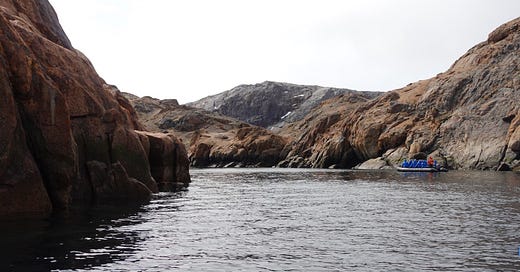Fun with kelp(!) in Lower Savage Islands
On board an expedition ship such as Ocean Endeavor, there’s rerouting, rescheduling, and reimagining day to day and hour to hour. Up in the arctic, you can’t really make a plan and stick to it—you’ve got ice, wind, tides, and wild animals that will shake things up without warning.
For the next 2 weeks, the expedition team (our zodiac drivers, bear guards, and environment/wildlife/culture experts, many of whom overlap in these duties) would be taking us on zodiac transfers from the ship to various islands, towns, and shores off the mainlands. Our schedule would be briefed to us each morning or previous night, and we’d get a glimpse at maps and charts keeping us informed on ice, wind, and temperature. Our fearless Expedition Leader, Julie, kept a close eye on conditions with her team to assess our routes and make changes if necessary.
So, you really don’t know what’s going to happen each day. That’s what makes it truly an expedition. This spirit of spontaneity and adventure comes with a reminder that while the arctic is a vast and beautiful part of the world to travel through, it requires attention, safety, and respect.
Because of this unpredictability, Adventure Canada had multiple A, B, and C plans in play. While Day 2 option A was a landing on the Lower Savage Islands, anchoring proved a challenge. So option B—a zodiac cruise—it was. We geared up and dropped all 20 zodiacs into the water to take a closer look at the rock formations and try to spot wildlife. My particular driver that day, Deanna, Marine Biologist, was rich with knowledge and willing to share ample of it. At one point, she leaned out over the water and pulled in a large piece of kelp.
The kelp was slimy and thin, with sunlight pouring through the wide leaves as Deanna held it high for us to see.
Kelp have long stems that float, allowing the leaves to remain close enough to the surface to photosynthesize. They are fast growing and really essential to our Earth’s ecosystems, providing habitats for fish and taking in immense amounts of carbon dioxide. Photosynthesizing algae actually produce 70% of the world’s oxygen! Since we are in polar bear land, we also learned that the bears snack on them for the salt and to help with digestion.
Kelp farms are actually becoming more popular as a more environmentally friendly way to feed cows, too. Cows produce a lot of methane because of their current diet (think corn). It’s been found that feeding them kelp is actually a great alternative—up to 90% of their methane production could be reduced. Not only is it also great food fare for humans, too, but it is added into things like ice cream and lipstick to held maintain their structure.
Go kelp go!
While no polar bears were spotted, we saw a particularly large quantity of black guillemots, seabirds related to penguins, with black bodies, white patches on their wings, and little red feet. When they fly, their wings look like those little helicopters that fall from the trees during summer back home in Chicago…
In the afternoon, the Inuit expedition team members introduced themselves and shared a bit about their diverse communities, which ranged from locations within Nunavik to Nunavut to Greenland.
Robert, one of our Inuit Cultural Educators, talked a bit more extensively about the South Baffin region through the lens of his personal family history. Below is a video of him showing us his kamik, boots made of animal skin. Here, he shares how they are expertly stitched in order to withstand the demands of the wet and chilly tundra.
We were so lucky to have many Inuit leaders on board who shared their knowledge and culture with us each and every day, on board and off. It was with their guidance that we made this journey gaining a richer understanding of the people and places of the Canadian arctic and Greenland.
More to share soon!
Song of the Week
Back home in the states, we’re heading toward the last stretches of summer and starting to prep for the upcoming fall season. Kids are going back to school, and the Halloween candy is already making its way to store shelves. It’s this time of year that my playlists tend to begin their shift from beat-heavy, upbeat pop hits to soulful, acoustic classics. Anyone else a Joni-in-the-fall fan?





